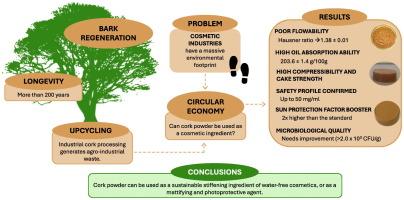软木粉:作为可持续化妆品成分的优点和局限性
IF 4.6
2区 工程技术
Q2 ENGINEERING, CHEMICAL
引用次数: 0
摘要
为了弥补化妆品行业对环境造成的巨大影响,该行业的目标是建立一个循环生产/消费系统,同时解决消费者对自然资源开采加剧的担忧。软木行业产生的大量农用工业废料,因其具有可持续和再生能力而备受关注。这项研究旨在探索软木塞加工的副产品--软木塞粉作为化妆品原料的特性。研究了这种粉末的流动性和可压缩性,并设想了它在固体无水配方中的用途,以及在护肤和防晒配方中作为功能性成分的潜力。软木粉末具有较高的可压缩性和结块强度,有利于配制无水压制粉末。不过,在配方设计中应考虑到流动性较差的问题(豪斯纳比率为 1.38 ± 0.01)。该粉末还具有较高的吸油能力(203.6 ± 1.4 克/100 克)和提高防晒系数(SPF)的效果,与标准配方相比,防晒系数提高了两倍。最后,软木粉末的安全性在代表人体表皮的细胞中得到了证实,最高可达 50 毫克/毫升。该产品的局限性与天然产品有关,即微生物负担较高。在考虑工业应用之前,应解决这一问题以及稳定性和可重复性问题。软木粉末具有多功能性,可用作固体/无水装饰化妆品的可持续硬挺成分剂,或用作哑光和光保护剂。本文章由计算机程序翻译,如有差异,请以英文原文为准。

Cork powder: Benefits and limitations as a sustainable cosmetic ingredient
To compensate for the massive environmental footprint of the cosmetic industry, this sector aims at a circular production/consumption system while intersecting the consumers' concerns about the exacerbated exploitation of natural resources. The high amount of agro-industrial waste generated by cork industries is of great interest due to the sustainable and regenerative capabilities of Quercus suber bark. This work aimed to explore the properties of cork powder, a by-product from cork processing, as a putative cosmetic ingredient. This powder was studied regarding the flowability and compressibility envisioning its use in solid water-free formulations, as well as the potential use as a functional ingredient in skin care and sun care formulations. Cork powder revealed a high compressibility and cake strength, which favors the formulation of water-free pressed powders. Poor flowability (Hausner ratio of 1.38 ± 0.01) should be, however, considered in the formulation design. The powder also revealed high oil absorption ability (203.6 ± 1.4 g/100 g) and sun protection factor (SPF) boosting effect, increasing SPF twofold when compared to a standard formulation. Ultimately, the safety profile of the cork powder was confirmed in cells representative of the human epidermis up to 50 mg/mL. Limitations of this product are associated with being a natural product, namely a high microbiological burden. This issue, along with stability and reproducibility should be addressed before considering industrial application. Cork powder showed a multifunctional profile, supporting its use as a sustainable stiffening ingredient agent of solid/water-free decorative cosmetics, or as a mattifying and photoprotective agent.
求助全文
通过发布文献求助,成功后即可免费获取论文全文。
去求助
来源期刊

Powder Technology
工程技术-工程:化工
CiteScore
9.90
自引率
15.40%
发文量
1047
审稿时长
46 days
期刊介绍:
Powder Technology is an International Journal on the Science and Technology of Wet and Dry Particulate Systems. Powder Technology publishes papers on all aspects of the formation of particles and their characterisation and on the study of systems containing particulate solids. No limitation is imposed on the size of the particles, which may range from nanometre scale, as in pigments or aerosols, to that of mined or quarried materials. The following list of topics is not intended to be comprehensive, but rather to indicate typical subjects which fall within the scope of the journal's interests:
Formation and synthesis of particles by precipitation and other methods.
Modification of particles by agglomeration, coating, comminution and attrition.
Characterisation of the size, shape, surface area, pore structure and strength of particles and agglomerates (including the origins and effects of inter particle forces).
Packing, failure, flow and permeability of assemblies of particles.
Particle-particle interactions and suspension rheology.
Handling and processing operations such as slurry flow, fluidization, pneumatic conveying.
Interactions between particles and their environment, including delivery of particulate products to the body.
Applications of particle technology in production of pharmaceuticals, chemicals, foods, pigments, structural, and functional materials and in environmental and energy related matters.
For materials-oriented contributions we are looking for articles revealing the effect of particle/powder characteristics (size, morphology and composition, in that order) on material performance or functionality and, ideally, comparison to any industrial standard.
 求助内容:
求助内容: 应助结果提醒方式:
应助结果提醒方式:


